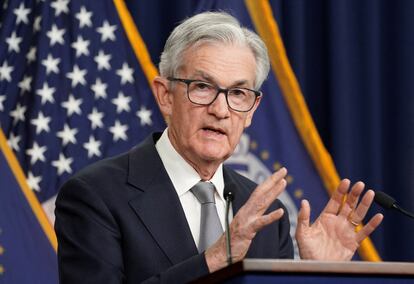Investors await clues from the Fed on when and how much rates will be lowered
Chair Jerome Powell will keep the price of money in the United States at the highest level in nearly 23 years


Investors and analysts are assuming that interest rates have peaked in the United States. Although Federal Reserve Chair Jerome Powell is trying to keep alive the possibility of an additional turn of the screw, in reality the question is no longer whether the price of money will rise further. What is being discussed now is when the declines will take place, and how intense they will be. On Wednesday there will be some clues in this regard after the meeting in which rates are expected to remain in the range of 5.25%-5.50%, the highest level since March 2001.
The Fed has not raised rates since July, but has managed to keep the market on edge with its repeated warnings that it is willing to raise rates if inflation does not ease to the 2% target. Although it is possible that Powell will reiterate that message on Wednesday, the market is beginning to believe that he is bluffing a bit. Keeping that option open allows you to dodge question about downgrades.
“Most data since the November meeting point to moderation in activity, disinflation and a cooling labor market. It is likely that the Federal Reserve’s confidence that its current monetary policy is appropriate and sufficiently restrictive has increased. In our opinion, the next policy measure will probably be a cut,” point out economists at BofA Securities, who believe that a hawkish message would not be very credible at this time. “One of the main questions that the committee will consider is the intensity with which it wants to signal that it has adopted a relaxation bias.”
Even before the Fed chair appears at a news conference, the central bank will publish the forecasts of the members of the monetary policy committee on inflation, unemployment rate, economic growth and, above all, interest rates. As they do every quarter, those responsible for monetary policy will try to anticipate what they themselves are going to do, although they are often wrong.
The last mistake was made in September, when the majority expected an increase of 0.25 points more in the price of money before the end of the year, a forecast which has not finally come to pass. The tightening of financial conditions due to the rise in long-term interest rates (which have now eased) did the dirty work for the Federal Reserve.
At that time, in addition, the markets had adopted the thesis of higher rates for longer, and the forecasts of the committee members indicated that the rates would be in the range of 5.00%-5.25% by the end of 2024. That implied a half-a-point cut during 2024. On Wednesday, the market will be awaiting both the updated forecasts and the message by Powell. Economists at Bank of America, for instance, said they expect forecasts will point to a cut of 0.75 points from the current level, which would leave them at the end of 2024 at 4.6%, that is, the range of 4 .50%-4.75%.
“Jerome Powell will probably try to guide the market towards greater caution, in line with his latest public statements,” says Gilles Moëc, chief economist at Axa Investment Managers. He believes that the forecasts will indicate to the market that cuts are coming, but not as many as are currently expected. “While a move in early spring, rather than June, our base case, is gaining plausibility, we don’t see what the upside would be for the Fed to give a nod to current market prices while the economy. It remains strong enough to keep inflation risks alive,” he adds.
One of the problems with the forecasts is that they indicate where committee members believe rates will be at the end of next year, but not the steps by which they will reach that level. The market is divided on the timing of the first cut. January 31 has already been discarded so, the bets are spread between March 20, May 1 and June 12, the other dates on which there will be decisions on rates in the first half of next year.
In the news conference after the meeting on November 1, Powell tried to silence the debate on rate cuts and leave the door open to a hypothetical additional rise, even if it is not at this December meeting. He then said that the idea that it would be difficult to make a rate hike again after stopping for a meeting or two is not correct. But he also said that the committee was not thinking about rate cuts at that time. “We are still very focused on the first question, which is, have we achieved a monetary policy stance that is restrictive enough to reduce inflation to 2% over time in a sustainable way?”
The chairman of the Federal Reserve is avoiding claiming victory too soon, especially while inflation remains above 3%. Powell wants to leave behind a soft landing, that is, controlling inflation without causing a full-blown recession. This has been his goal for more than a year. Alan Greenspan achieved it in the last decade of the last century, but the former Fed chair Powell really admires is Paul Volcker, who managed to stabilize prices against all odds.
Sign up for our weekly newsletter to get more English-language news coverage from EL PAÍS USA Edition
Tu suscripción se está usando en otro dispositivo
¿Quieres añadir otro usuario a tu suscripción?
Si continúas leyendo en este dispositivo, no se podrá leer en el otro.
FlechaTu suscripción se está usando en otro dispositivo y solo puedes acceder a EL PAÍS desde un dispositivo a la vez.
Si quieres compartir tu cuenta, cambia tu suscripción a la modalidad Premium, así podrás añadir otro usuario. Cada uno accederá con su propia cuenta de email, lo que os permitirá personalizar vuestra experiencia en EL PAÍS.
¿Tienes una suscripción de empresa? Accede aquí para contratar más cuentas.
En el caso de no saber quién está usando tu cuenta, te recomendamos cambiar tu contraseña aquí.
Si decides continuar compartiendo tu cuenta, este mensaje se mostrará en tu dispositivo y en el de la otra persona que está usando tu cuenta de forma indefinida, afectando a tu experiencia de lectura. Puedes consultar aquí los términos y condiciones de la suscripción digital.
More information
Archived In
Últimas noticias
Most viewed
- Sinaloa Cartel war is taking its toll on Los Chapitos
- Oona Chaplin: ‘I told James Cameron that I was living in a treehouse and starting a permaculture project with a friend’
- Reinhard Genzel, Nobel laureate in physics: ‘One-minute videos will never give you the truth’
- Why the price of coffee has skyrocketed: from Brazilian plantations to specialty coffee houses
- Silver prices are going crazy: This is what’s fueling the rally










































